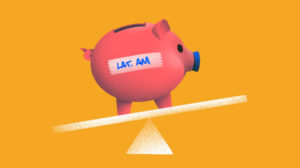Fintech startups are increasingly leaning into lending for the more than one-third of Americans with subprime credit scores. Their vision is to turn a negative connotation into one that not only helps short-term borrowers, but builds their credit and provides financial education.
Subscribe to the Crunchbase Daily
The term “subprime” is typically applied to a borrower with less-than-perfect credit and a FICO score of below 670, a category that 34.8 percent of Americans fall into, according to credit bureau Experian. (FICO is an abbreviation for the Fair Isaac Corp., the first company to offer a credit-risk model with a score.)
People in this category tend to have few borrowing options other than a subprime lender, which can lead to a cycle of debt, according to Josh Sanchez, co-founder and CEO at financial app FloatMe.
“The problem at large is there are no alternatives to payday loans,” Sanchez told Crunchbase News. “Overdraft fees are also a huge problem. Even during the pandemic, banks were charging overdraft fees knowing that people lost their jobs.”
In 2019, about 37 percent of Americans reported they didn’t have enough to cover a $400 emergency expense, according to the Federal Reserve.
And when they get into an emergency, there are not many places for people to receive loan help, according to Nathalie Martin, professor and Frederick M. Hart Chair in Consumer and Clinical Law at the University of New Mexico School of Law.
“Studies have found that people don’t shop around, mainly because of the desperation involved and the fact that there is not much difference in the pricing of the payday loans,” Martin said in an interview.
She sees two problems with the current loans: Lending fees are often high compared to the loan — think a $50 fee for a $100 loan — and people often get caught in a “debt trap” where they keep paying those fees and never actually pay off the principal of the loan, resulting in paying much more than was originally borrowed.
Borrowers desperate for cash often don’t look closely at the cost of the loan when they’re seeking a lifeline, she said, only to realize as they’re paying it off how expensive it truly is.
Investing in new methods
Since 2017, more than $94 billion has been invested in U.S. companies focused on financial services, per Crunchbase data. Between 2019 and 2020, there was a 29 percent boost in funding dollars, though the number of investments was down nearly 13 percent. So far in 2021, $19.5 billion has been invested into the sector.
Over the past six months, venture capital investors have funded a number of startup companies focused on alternatives to payday lending and financial literacy, including FloatMe, which in December raised a $3.7 million seed led by ManchesterStory.

Other recent U.S. investments in the space include:
- New York-based credit card company Petal closed on more than $126.6 million in a debt facility backed by Silicon Valley Bank and Trinity Capital to expand its credit card programs for those who are new to credit and overlooked by big banks.
- San Francisco-based SeedFi announced a $15 million Series A raise led by Andreessen Horowitz for its platform aimed at building credit, savings and financial planning.
- Stilt, also based in San Francisco, provides financial services for immigrants and raised a $100 million debt facility from Silicon Valley Bank to support its lending product and new checking account product for customers and people without credit.
- Los Angeles-based SoLo Funds raised $10 million in Series A funding, led by ACME Capital. The company is building a new type of peer-to-peer lending group in which strangers fund strangers asking for short-term personal loans for immediate needs.
Latin America has also become a hot market for startup innovation in the consumer lending category. Mexico City-based Graviti earlier this month raised $2.5 million in a seed round led by Active Capital to develop a buy now, pay later concept aimed at millions of low-income, unbanked families in Latin America for whom purchasing home appliances is difficult.
Baubap, a mobile lending platform also based in Mexico, in March closed on a $3 million growth round from Mexican financial services firm Grupo Alfin for its proprietary technology aimed at boosting financial inclusion and education. And last November, Monashees and ONEVC led a $5 million seed round in Brazilian fintech startup Facio, which is developing a financial education platform that not only offers free lectures and courses, but also salary-advance services.
Seeing the success of companies, such as Chime, that are serving subprime borrowers has been a big driver for the investment, said Rebecca Lynn, co-founder and general partner of Canvas Ventures.
“I’ve seen a lot of people tap into apps that help you get your money two days early, as well as more real-time access to funds to pay bills when they get them,” Lynn told Crunchbase News. “You are not waiting for a pay cycle, there is cash-based underwriting made possible by companies like Plaid, and it is much less expensive to service users.”
Lynn spent 20 years in the credit industry, experiencing multiple cycles. She cautions other investors that subprime is a dangerous category to play in and that firms should choose companies wisely based on how operations are truly running.
In 2019, Canvas invested in Possible Finance, a Seattle-based company that helps people with little to no credit history gain access to credit and improve their financial future “without being predatory,” Lynn wrote in her blog post.
“Possible has done well in COVID, which pressure-tested it,” she added.
Swapping cash flow for credit
Sanchez himself had his own brush with payday lending: He was involved in a car accident and didn’t have a credit card, so he took out a payday loan that ended up putting him in financial hardship.
That prompted him and two co-founders to start Austin-based FloatMe in 2018 to provide interest-free and credit-free “floats” of up to $50, account monitoring to prevent overdrafts, and savings and education tools.
If more people like Sanchez, who have experienced the negative aspects of the payday loans firsthand, would come into the lending space with transparency and education, it will be good for the industry, Martin said.
“We have a chance of making it work for people,” she added.
Sanchez found that when someone qualified for an advance of $200, even if a person didn’t need the entire amount, they often took it, but then found themselves in a $200 hole as interest and fees racked up. Instead, smaller amounts — think $20, $30 or $50 — are easier to pay back, he said.
“The solution is proving that even a small amount can make a difference,” he added. “It could mean being able to put gas in your car or paying the minimum payment on a credit card or buying food.”
Over the past three years, FloatMe has processed nearly 1 million of its small “floats,” which use cash flow underwriting as the basis for the loans versus the traditional credit score, which is not “one-size-fits-all,” Sanchez said.
The cash flow method means the company looks at the borrower’s expenses going out the day prior to and the day after someone’s payday and what income is coming in. That method has enabled FloatMe to make good decisions and trust in a model that it can supplement credit scores, he added.
FloatMe plans to expand beyond helping consumers with their cash shortfalls, Sanchez said. The company has a budgeting feature in the works to be released at the end of May, and is exploring other income-earning opportunities for users. It may also offer credit products in the future.
“The largest expenses someone has are rent and bills, which leave a little bit of capital for the rest of the month,” Sanchez said. “It’s hard to get out of that situation. We need to be doing better as an economy to unlock earning potential and keep down the rising costs of living.”
Regulatory approach
When President Joe Biden took office in January, one of his stated priorities included investigating payday lending, suggesting that the Consumer Financial Protection Bureau would become a “consumer watchdog” under his administration.
Biden nominated Rohit Chopra, who has been vocal about fighting lending abuse, to the top job at the bureau.
The U.S.’ credit and lending problems will not be easy to solve, Lynn said. She’s seen different incarnations of the payday loan concept, including some that offer loans with zero interest but a subscription fee.
There should continue to be options for consumers who live paycheck to paycheck to manage and improve their finances, coupled with financial literacy education, she said.
“If all credit options were taken away, it wouldn’t allow someone to grow,” Lynn said. “Companies also need to provide credit in a way that is transparent and ethical.”
Payday lending interest rates are regulated on a state level. That means it would be difficult for the federal government to set an interest rate cap, although a federal cap would be one way to address the problem, Martin said. CFPB has created some rules for lenders, including “The 2017 Rule,” which prohibited lenders from debiting a borrower’s account under certain conditions, as well as requiring lenders to determine whether borrowers could repay their loans.
Another would be giving the CFPB more power to investigate lenders.
“Some of the smaller loans may have higher interest rates and might need a higher cap, but there could also be solutions like a waiting period between loans or limitations on the number of loans someone could take out in a certain period,” Martin added. “It is also time to start thinking how one might regulate new products being offered.”
Crunchbase Pro queries listed for this article
The query used for this article was U.S. Financial Services Company Funding Since 2017, in which “financial services” was the industry group and companies headquartered in the United States. This list includes companies identified as financial services, but also includes companies in other categories, such as insurance, energy, fraud detection and software.
All Crunchbase Pro Queries are dynamic with results updating over time. They can be adapted with any company or investor name for analysis.
Illustration: Dom Guzman

Stay up to date with recent funding rounds, acquisitions, and more with the Crunchbase Daily.








67.1K Followers